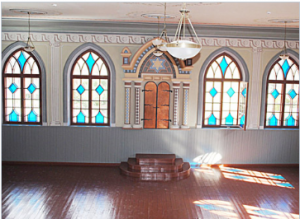Restoration work has been completed on the interior of the hall of the Red Synagogue in Joniškis (Yanishok), Lithuania. It lost part of its roof in 2004 in a wind storm, and suffered a partial collapse in 2008 due to neglect, but now the town has regained one of its most significant cultural symbols. The plan is for the synagogue to open its doors to the public in 2015 and for it to house a permanent museum exhibit.
Before restoration work began, the Red Synagogue had all of its roof missing and its eastern wall as well, and water had damaged all but perhaps a quarter of the interior. Financing from an EEA and Norway grant was used in conjunction with funding from Lithuanian Heritage Protection Department and from the Joniškis municipality to restore the structure and the interior.
Historical imagery was used to restore the ceiling and ceiling and wall decor. Door and window frames, a wooden statue of a girl and the balcony were also restored using visual documentation, as was the Ark of the Torah.
Diana Varnaitė, director of the Lithuanian Heritage Protection Department, said the restoration of the Red Synagogue was yet another historical building which had been brought back to life, but more importantly demonstrates that the memory and shared history of Jewish and Lithuanian countrymen who lived and worked together in Joniškis is still important to the whole country. “This synagogue is exceptional not just because it is part of a synagogue complex, which is rarely seen, but also because even when it was in disrepair it still drew the community, and it was the venue when possible for events, including especially popular concerts by jazz musicians. The synagogue under construction was a significant part of city culture, and its restoration was a matter of concern for the entire Joniškis community,” Varnaitė said.
The Red Synagogue is part of a synagogue complex which includes the White Synagogue as well. It was built in the latter half of the 1800s, when about half the population of the town was Jewish. It suffered a fire in 1911 but was quickly renovated then. It was used for various purposes in Soviet times, including as a metal foundry, a youth club and as residential housing. The plan currently is for the Red Synagogue to house a permanent exhibit of the Museum of History and Culture, and for the White Synagogue to host concerts and other exhibits.


